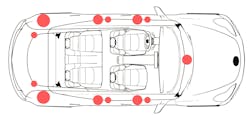Machine Learning Plus Precise Cabin Measurements Transforms Any Vehicle’s Sound Experience
What you’ll learn:
- Why vehicle interiors are an extremely challenging acoustic environment.
- How Dirac uses data measurements to determine each car’s unique “acoustic fingerprint.”
- What is a “super speaker” and how does Dirac create one?
- How to reproduce multichannel content without noticeable artifacts in the sound.
Vehicle interiors are one of the modern world’s most challenging environments for delivering high-quality audio, but one Swedish company found a way to overcome it. Dirac Research combines its most advanced digital correction technology (MIMO mixed phase impulse response correction) with machine learning to “teach” vehicles how to intelligently combine their speaker outputs for optimized performance.
The Challenge of Multiple Speakers
The average vehicle interior is a tight space housing anywhere from four to more than 30 speakers directed at one to seven listeners in different positions, with a wide variety of surfaces featuring different angles, materials, and acoustic properties.
Vehicle interiors have multiple speakers directed at different positions, causing misaligned sound waves due to complex surfaces and acoustic properties. While equalization can enhance sound quality, it can’t fix details of the timing errors between speakers.
Data Mining for a Solution
Dirac Research has more than two decades of scientific expertise improving sound experiences in homes, theaters, vehicles, headphones, and even mobile device speakers. Since every vehicle model is unique, the company had to create a sophisticated acoustic measurement system that pairs patented algorithms with a large dataset of measurements. That combination was used to create an accurate acoustic fingerprint showing how each speakers’ output is affected by the in-cabin environment, and how it’s perceived at each seat location.
Of course, automobile audio design has involved microphones for a long time. To ensure the most accurate and usable data, Dirac’s system utilizes 16 microphones per speaker channel per seating position, resulting in a vast number of measurements—i.e., in a four-seat car with 20 speakers it would capture 1,280 measured impulse responses (see figure).
Creating a Blank Audio Canvas
Since every vehicle is different, delivering similar experiences in them requires tearing down each cabin’s unique characteristics and correcting them so that the sound experience resembles a bare studio. Some OEM partnerships have even involved Dirac input on the design and placement of speakers.
To turn each complex vehicle interior into a blank audio canvas, Dirac engineers use the data collected during the measurements. The company’s patented MIMO mixed phase impulse response correction then creates groupings of speakers that support each other’s impulse response characteristics and form what has become known as a “super speaker.”
With super speakers, the company can deliver convincing Sound Field Control that allows listeners to perceive bass as coming from right in front of them, even if the subwoofer is mounted far away in the trunk, for example. While Dirac’s experts guide the process, the brute-force calculations are completed by tools using patented algorithms because there’s simply too much data for humans to process.
Give the People the Immersive Experience They Want
While most audio recordings are still conducted and processed in two-channel stereo, some consumers have become accustomed to the immersive experiences delivered only by home theaters and multichannel systems.
For decades, upmixers have provided a rudimentary means of turning a two-channel signal into multichannel output, but virtually all of them produce artifacts in the signal that affect the sound to varying extents. Dirac’s solution was developed with the intention of delivering the best immersive experience achievable while avoiding any audible artifacts.
Using Dirac’s Dynamic Spatial upmixer technology makes it possible to remain true to the source material by spatially rearranging the output without adding or subtracting any signal. The multichannel content then gets distributed or rendered to match the specific hardware system architecture in the vehicle.
The Dirac Intelligent Audio Platform is another important foundation to the company’s work, providing a common platform that empowers implementation of customer-specific integration faster and with greater replicability in future models.
Looking Beyond the Curve
As auto manufacturers look to reduce complexity for entry-level vehicles, Dirac technology could be vital to optimize soundbar-like designs as well as support even more complex systems such as in-ceiling speakers for Dolby ATMOS audio formats in luxury vehicles.
One thing Dirac is certain of is that audio engineers will remain vital to both its internal product design and the implementation in vehicles and devices. While algorithms and testing can get us about 80% of the way to a completed solution, the last 20% absolutely requires a professional hand with subjective experience.

